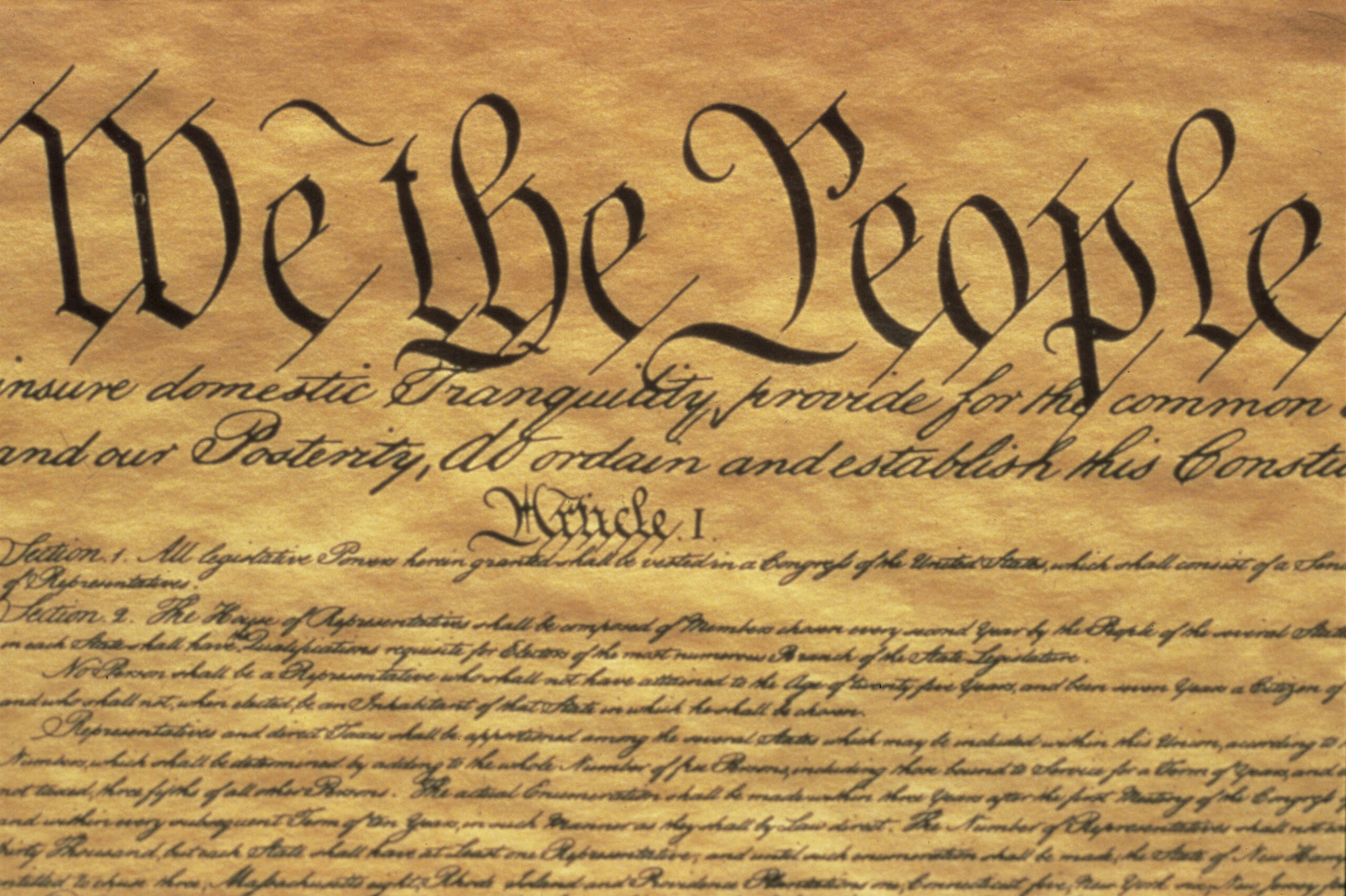Over the coming months, the George W. Bush Institute will explore the nature of pluralism and how it’s working in our country. Improving our commitment to pluralism is intrinsically tied to strengthening our democracy.
“Is the juice worth the squeeze?” Tirien Steinbach, Stanford Law School’s Associate Dean for Diversity, Equity, and Inclusion, asked during a Stanford event in March. Her question thrust the gathering – and the role of free speech on college campuses – into the national spotlight.
Stanford’s Federalist Society had invited Judge Stuart Kyle Duncan, whom President Donald Trump had appointed to the Fifth Circuit of the United States Court of Appeals, to speak. A group of students who disagreed with Duncan’s legal positions on issues like gender identity disrupted the convening in protest. Verbal barbs flew between both sides, leaving neither the students nor Duncan cloaked in virtue.
Dean Steinbach herself was the most prominent protester. Although she acknowledged Stanford’s commitment to free speech, Steinbach used her position as an administrator to take the podium and question the event’s organizers and the judge on whether his remarks were worth the “harm” they might cause.
“Do you have something so incredibly important to say about Twitter and guns and COVID that that is worth this impact on the division of these people who have sat next to each other for years, who are going through what is the battle of law school together, so that they can go out into the world and be advocates?” the school administrator asked the judge.
Headlines soon blared across the country, while video of the meeting went viral. Stanford officials quickly apologized to Judge Duncan, but the backlash continued. Two weeks later, Jenny Martinez, the Dean of Stanford’s Law School, made her own front-page news.
She released a 10-page memo that reaffirmed the university’s commitment to free speech: “I believe that the commitment to diversity, equity and inclusion actually means that we must protect free expression of all views,” Martinez wrote.
The uproar over this episode illustrates the tensions that exist between freedom of speech, inclusion, and security in American society. As we will note in this essay, the tension is not limited to Stanford. In fact, conflict may be unavoidable as free societies grapple with these fundamental questions and try to find some kind of balance.
Liberties like free speech are meaningless, however, without a broad commitment to pluralism and its emphasis on tolerance for people and groups with differing views, backgrounds, and beliefs. Ultimately, it’s pluralism that helps us better understand the value of our freedoms and navigate the rifts between notions of free speech, inclusion, and security.
Why does free speech matter?
Abolitionist Frederick Douglass called free speech the “dread of tyrants.” In fact, his “Plea for Freedom of Speech in Boston” masterfully summarizes how and why freedom of expression is a cornerstone of liberal democratic societies.
Douglass’ address extolled the virtues of free speech after an angry mob shut down – some, today, may say canceled – a previously planned gathering. He called the right to speak one’s mind, “the great moral renovator of society and government” and argued that “liberty is meaningless where the right to utter one’s thoughts and opinions has ceased to exist.”
“Liberties like free speech are meaningless, however, without a broad commitment to pluralism and its emphasis on tolerance for people and groups with differing views, backgrounds, and beliefs.”
Douglass also highlighted a component of free speech that may not be top of mind when this topic is typically discussed. He argued that the ability to express oneself freely has two beneficiaries: the person speaking and the person receiving those thoughts. As Douglass put it, “Equally clear is the right to hear. To suppress free speech is a double wrong. It violates the rights of the hearer as well as those of the speaker.”
Even so, freedom of expression can be complicated as we consider its most hateful, audacious, and crude forms. There are arguments about limiting free expression – in which college campuses and social media seem to be the primary battlegrounds – that suggest some speech is harmful or excludes others, and therefore shouldn’t be permitted.
Debating freedom of expression
Freedom of expression is essential for a free, pluralistic, and democratic society to endure, as Douglass argued. It allows for the free flow of ideas and scrutiny that makes for a vibrant press, an informed citizenry, limited and accountable government, a healthy academic environment dedicated to the pursuit of truth, and a culture that allows for compelling (and provocative) artistic expression.
Certainly, the American founders believed this as they enshrined the concept in the Bill of Rights as part of the First Amendment to the U.S. Constitution. At the same time, the law doesn’t protect absolute freedom of expression and speech, such as disorderly conduct.
It’s also true that constitutional protections for freedom of expression don’t shield an individual from cultural or social consequences for provoking controversy. For example, it’s legal for people to respond to you on social media with nasty remarks or for a moderator to remove an inflammatory opinion you post on Facebook. Some people even lose jobs and relationships based on attitudes they express.
The debate around these consequences, their severity, and what kinds of expression elicit them is often called “cancel culture.” As Pew research shows, many Americans fall into two distinct camps on this issue: those who see it as “accountability” and those who believe it is “censorship.”
Perhaps they’re both correct to some extent. There are some people, who, in their zeal for greater accountability, create witch hunts. In a 2020 piece for The Atlantic, Yascha Mounk cataloged an array of people who had been “canceled” – in some cases losing their livelihood – because they were merely perceived to have engaged in what some in the culture had deemed unacceptable forms of expression.
For example, in the wake of George Floyd’s murder, progressive data analyst David Shor retweeted a study on how violent protests were linked to poor electoral performance for Democrats. After the tweet received an angry backlash, Shor was fired from his job at Civics Analytics. In this scenario, accountability became a matter of mob justice, not due process. This can create a chilling effect that stymies authentic dialogue and fosters insincere groupthink.
On the other hand, some people equate blocking or debunking disinformation around things like the 2020 elections as censorship. However, the term “censorship” principally – though not exclusively – refers to government suppression. Private institutions are exercising free expression when they moderate content for views they find malicious or potentially objectionable, like pornography. While such institutions may deserve criticism when they overreach or overreact, it’s still their prerogative to do so.
These challenges aren’t new. The ancient Greeks wrestled with questions around the limitations of free expression. As scholar Teresa M. Bejan detailed in a 2017 Atlantic article, there were two main conceptions of free speech recognized in ancient Greece: isegoria and parrhesia. “Isegoria described the equal right of citizens to participate in public debate in the democratic assembly; parrhesia, the license to say what one pleased, how and when one pleased, and to whom,” she wrote.
These two interpretations of freedom of expression – with isegoria emphasizing equality and parrhesia liberty – are central to current debates around speech, particularly on college campuses, Bejan argues.
Perhaps what is missing, Bejan notes, is a commitment to a third form of expression described by the ancient Greeks and championed by the likes of Plato and Aristotle called logos – “reason or logical argument” – which wasn’t regularly associated with either isegoria or parrhesia.
The best approach lies with maximizing the space for acceptable expression – particularly in the cultural context. Ideally, this would mean rejecting an environment in which the fear of social consequences restrains the authentic expression of ideas and adversarial opinions while at the same time engaging with others in the spirit of civility.
As a country, we must deal with controversial and uncomfortable ideas all the time. Former Secretary of State Condoleezza Rice put it well when she said during a Reimagining Democracy event: “We don’t have a constitutional right to be comfortable.”
Moreover, we must accept that not everyone shares the same views on issues that we do. This doesn’t mean that such viewpoints should be immune from sharp criticism – on the contrary, dialogue or reasoned argument should be a preferred method for engaging with different opinions and refining our own views.
“The best approach lies with maximizing the space for acceptable expression – particularly in the cultural context.”
Democracies like the United States must find the appropriate balance in the tension between individual liberty and civic virtue around freedom of expression. In other words, the logos-infused “sweet spot” between isegoria and parrhesia.
A commitment to pluralism
Foundational to this balance, but perhaps overlooked, is a robust commitment to pluralism that helps maintain a tolerant, diverse society that encourages the free flow of ideas.
College campuses and students should be an important area of focus for improving our commitment to pluralism. Not only does this population represent the generation that will primarily shape American society in the coming decades, but it’s also on the front lines of debates around freedom of expression.
Analysis by the American Enterprise Institute (AEI) reveals that ideological diversity on campuses may be an area of concern. AEI – looking at faculty, students, and administrators – found significant overrepresentation on the ideological left in all three of these campus constituencies.
The same analysis compared those findings to the overall American population which shows a more balanced ideological representation – a plurality identifying as “moderate,” roughly one quarter as “liberal,” and just under a third as “conservative.”
It’s reasonable to be concerned that students who aren’t exposed to broader viewpoint diversity will fundamentally misunderstand the character of the nation they will be leading.
As David French explained in a conversation at the National Constitution Center, having a healthy commitment to pluralism is essential to free speech protected by both laws and culture. Along with promoting social tolerance, pluralism provides space for people from different backgrounds to share their views and practice their beliefs without reprisal.
French cites James Madison’s “Federalist Papers No. 10” as the foundational point in this argument. Paraphrasing Madison, he talks about the tendency of people to form factions and come into physical conflict and says, “You don’t deal with the violence of faction by inducing conformity or by extinguishing liberty, but essentially letting mini-factions flourish.”
By creating and protecting a regime that enshrines pluralism and free speech, these human tendencies to violence are given another outlet – through expression and democratic institutions – to pursue interests and ideas.
The climate on campuses
What happens when this commitment to pluralism is weak or even alien to students on campus?
In 2022, the Foundation for Individual Rights and Expression (FIRE) conducted a national survey of university students that provides a snapshot of various campus attitudes on this topic. Half of the students reported feeling at least some pressure not to raise controversial topics in class. Nearly half said they wouldn’t feel fully comfortable raising controversial topics with their peers during discussions in campus common spaces. And four in 10 expressed some level of discomfort publicly disagreeing with professors on controversial topics.
But why? In a George W. Bush Institute Democracy Talks exchange, Greg Lukianoff, President and CEO of FIRE, and Jamal Greene, the Dwight Professor of Law at Columbia Law School, suggested there is tension between free speech and inclusion.
Such tension may seem counterintuitive because the word “inclusion” implies wider participation for the exchange of ideas. However, it returns us to the ancient Greek concepts of isegoria and parrhesia (or equality vs. freedom). The “inclusion” being discussed specifically refers to ensuring that all voices – particularly those who have been historically marginalized like people of color – have equal access to the public square free from discrimination or harm.
“University leadership must also accept that in a pluralistic, multiethnic democracy, there will be inevitable controversies.”
Attempting to define “harm” has created a tug of war on campuses as to what constitutes equality of access and censorship. Some argue that any expression, regardless of intent, which causes the listener discomfort or offense is harmful and therefore unacceptable. In fact, it may require shouting down or taking a platform away from the speaker to maintain the safety of marginalized groups.
That idea returns us to the Stanford scenario asking if the “juice is worth the squeeze.”
Another example is the experience of Yale University’s Nicholas and Erika Christakis. In 2015, lecturer Erika Christakis publicly disagreed with an administrative advisory notice suggesting that students refrain from Halloween costumes that some people might interpret as cultural appropriation or insensitive.
She warned students to be wary of administrative dictates saying, “American universities were once a safe space not only for maturation but also for a certain regressive, or even transgressive, experience; increasingly, it seems, they have become places of censure and prohibition.”
Students confronted Erika’s spouse, Professor Nicholas Christakis, on campus. They wanted him to apologize for supporting his wife’s statement. When he refused, they swore at him, shouted, and even demanded his resignation. And while Nicholas remained at Yale, Erika left the university soon after the incident.
A study by the Knight Foundation and Ipsos reveals that there are aggrieved students on both sides of the issue. Sixty-five percent believe that their school stifles free expression – and that number has increased 9 percentage points since 2016. At the same time, nearly 20% of students report feeling unsafe on their campus because of comments made related to race, gender, ethnicity, religion, or sexual orientation.
This tension has led to various challenges to free expression on campuses. Confronting individual professors like Nicolas Christakis is one example. Rescinding an invitation to a speaker is another. This practice is not confined to the right or the left. Rather, both sides use it to deny platforms for people that faculty or student bodies view as representing a controversial, offensive, or even harmful point of view.
FIRE has maintained a database of disinvited college speakers dating back to 1998. It has cataloged 550 challenged or revoked speaker invitations, with 276 incidents occurring between 2015 and 2023. This surpasses the number of disinvited speakers logged during the program’s first 17 years of existence.
Prominent examples of speakers being disinvited (or facing attempts at disinvitation) include President Joe Biden, former Vice President Mike Pence, former Secretary of State Condoleezza Rice, former Secretary of Homeland Security Jeh Johnson, Georgia Secretary of State Brad Raffensperger, and historian Jon Meacham. These are not fringe or radical actors, but critical representatives of mainstream political culture and thought.
In the face of these challenges, an injection of logos (as Plato might have argued) is needed. Equipping students with the skills and temperament necessary for reasoned argument could lead to more productive engagement with diverse viewpoints. It would also help bridge the space between these two diverging conceptions of free expression by offering a structure that welcomes voices to express themselves through civil dialogue, debate, and disagreement.
There is tremendous value in this approach to free speech. Greg Lukianoff explains the benefits very well, distilling three core arguments from John Stuart Mill’s On Liberty as such:
-
- You are wrong, in which case freedom of speech is essential to allow people to correct you.
- You are partially correct, in which case you need free speech and contrary viewpoints to help you get a more precise understanding of what the truth really is.
- You are 100% correct; in the unlikely event that you are 100% correct, you still need people to argue with you, to try to contradict you, and to try to prove you wrong. Why? Because if you never have to defend your points of view, there is a very good chance you don’t really understand them and that you hold them the same way you would hold a prejudice or superstition. It’s only through arguing with contrary viewpoints that you come to understand why what you believe is true.
To their credit, various high-profile universities – including Stanford, Cornell, Penn State, and Harvard – have recently reinforced their commitments to ideas like “academic freedom” and “freedom of inquiry.”
The work of continuing to foster this mentality on campuses is well suited to a coalition of actors, including university administrators, faculty, student leaders, and nonprofits focused on college life.
“Equipping students with the skills and temperament necessary for reasoned argument could lead to more productive engagement with diverse viewpoints.”
Organizations like the Bipartisan Policy Center (BPC) are already doing this through their Campus Free Expression initiative. In a Democracy Talks interview, BPC’s Jacqueline Pfeffer Merrill commented that Generation Z students come to universities having only known homogenous neighborhoods and backgrounds. As a result, they often lack the skills to engage with classmates with different experiences and views.
And while engaging with others on campus is the responsibility of students, university leaders can create opportunities to promote better dialogue and understanding. BPC’s Campus Free Expression: A New Roadmap suggests that schools provide coaching and instruction for students during their first orientation sessions at school.
While this approach may seem rudimentary, imagine being a young adult who has never, or rarely, known people with different political views or religious beliefs. It’s almost like encountering a foreign country or culture for the first time. There will naturally be some level of confusion toward customs, practices, and what constitutes respectful behavior. Improving a student’s understanding could alleviate potential tension.
University leadership must also accept that in a pluralistic, multiethnic democracy, there will be inevitable controversies. In the same roadmap, BPC offers a series of specific scenarios and actions that faculty and staff can practice to better prepare themselves for managing controversy constructively.
And, of course, inherent in all this, is continual exposure and dialogue with speakers and peers who hold different points of view. Universities and student groups should be committed to providing space for that exchange. For example, the national student organization BridgeUSA is building the institutional structure for these spaces on college campuses across the country. They launched an eye-catching campaign encouraging dialogue that’s simply called, “Let’s F*cking Talk to Each Other.”
Conclusion
As Frederick Douglass highlights throughout his “Plea for Freedom of Speech in Boston,” free expression is the tool of the powerless and oppressed because it provides the framework to question and innovate the status quo. Without that ability, and its broad application to all society, tyranny is more likely to take root than not.
Moreover, a pluralistic society’s survival depends on citizens’ engaging with others from various walks of life, even if they are uncomfortable, offensive, or crass. Without that exposure, we’re tempted to shut out everything and anything we disagree with because it feels alien and wrong.
Even as the United States remains committed to preserving free expression, that doesn’t mean there aren’t serious concerns surrounding speech and its limitations. All actors must have equal access to the public square without fear of harm or reprisal.
But this should not conflate uncomfortable or provocative views with hate-based rhetoric or disinformation to silence opposing viewpoints. Thankfully, there are organizations developing strategies and tools to expand the space for and quality of free speech.

































